Abstract
The epidermal structures of the foliage leaves, prophylls (perigynia) and nuts of 26 species and one variety ofKobresia (24 species and one variety from the Himalaya and two species from outside Himalaya) were studied by a scanning electron microscope (SEM) with an aim of making clear the relationship among these species. Most of the epidermal structures of the leaf and prophyll showed generic or familial relationships. The epidermal structures of the nuts were found useful for showing inter-specific relationships among morphologically closely related species though these structures were not found to be consistent with the infrageneric classification ofKobresia recognized by Clarke (1894, 1908) and Kükenthal (1909). On the basis of the epidermal structures of the nuts revealed by SEM the species ofKobresia could be put into four groups.
Similar content being viewed by others
References
Clarke, C.B. 1894. Cyperaceae.In J.D. Hooker, ed., Flora of British India, vol. 6, pp. 585–748. L. Reeve and Co., London.
—. 1908. New genera and species of Cyperaceae. Kew Bull.1908: 1–196.
Denton, M.F. 1983. Anatomical studies of the Luzulae group ofCyperus (Cyperaceae). Syst. Bot.8(3): 250–262.
Dahlgren, R.M.T., H.T. Clifford and P.F. Yeo. 1985. The Families of the Monocotyledons. Springer-Verlag.
Ellis, R.P. 1979. a procedure for standardizing comparative leaf anatomy in the Poaceae. II. The epidermis as seen in surface view. Bothalia12: 641–671.
Govindarajalu, E. 1969. The systematic anatomy of South Indian Cyperaceae:Cyperus L. subgen.Kyllinga (Rottb.) Suringar. J. Linn. Soc., Bot.62: 41–58.
Koyama, T. 1961. Classification of the Family Cyperaceae (1). J. Fac. Sci. Univ. Tokyo Sect. III, Bot.8(3): 37–148.
Koyama, T. 1978. Cyperaceae.In H. Hara et al., ed., An Enumeration of the Flowering Plants of Nepal 1. pp. 96–120.
Kükenthal, G. 1909.Cobresia.In A. Engler, ed., Pflanzenreich IV-20, Ht. vol. 38, pp. 33–50. Wilhelm Englemann, Berlin.
Kukkonen, I. 1967a. Vegetative anatomy ofUncinia (Cyperaceae). Ann. Bot.31: 523–544.
—. 1967b. Spikelet morphology and anatomy ofUncinia Pers. (Cyperaceae). Kew Bull.21: 93–97.
Metcalfe, C.R. 1960. Anatomy of the Monocotyledons. I. Gramineae. Clarendon Press, Oxford.
—. 1971. Anatomy of the Monocotyledons. V. Cyperaceae. Clarendon Press, Oxford.
Palmer, G.P. and A.E. Tucker. 1981. A scanning electron microscope survey of the epidermis of east African grasses, I. Smithsonian Contr. Bot. no. 49.
Rajbhandari, K.R. andH. Ohba. 1987a. A new species ofKobresia from Nepal. J. Jap. Bot.62: 193–197.
— and —. 1987b. Two new Himalayan species ofKobresia sect. Hemicarex (Cyperaceae). J. Jap. Bot.62: 268–273.
Toivonen, H. andT. Timonen. 1976. Perigynium and achene epidermis in some species ofCarex subgenus Vignea (Cyperaceae), studied by scanning electron microscopy. Ann. Bot. Fenn.13: 49–59.
Author information
Authors and Affiliations
Rights and permissions
About this article
Cite this article
Rajbhandari, K.R., Ohba, H. Epidermal microstructures of the leaf, prophyll and nut in the himalayan species ofKobresia (Cyperaceae). Bot Mag Tokyo 101, 185–202 (1988). https://doi.org/10.1007/BF02488895
Received:
Accepted:
Issue Date:
DOI: https://doi.org/10.1007/BF02488895




